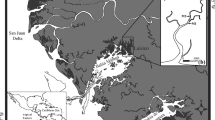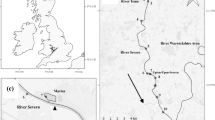Abstract
We studied daily tidal movements of tagged juvenile Lutjanus fulviflamma and Lutjanus ehrenbergii between two adjacent habitats, a subtidal channel and shallow tidal notches in the fossil reef terrace, in a shallow marine bay on Zanzibar Island (Tanzania). Due to a large tidal range, the notches were dry at low-tide and were only accessible to the snappers at high-tide. Of the resighted individuals, 48% showed clear movement between the two habitats, orientated in a direction perpendicular to the tidal currents. Individuals resighted more than once showed site fidelity, indicating homing in both the channel and the notches. We suggest that a significant part of this population of juvenile snappers may move from a low-tide resting habitat to a high-tide resting habitat during the daytime, perhaps to avoid predation by larger predators that may enter the channel at high-tide.
Similar content being viewed by others
References
Beets, J. 1997. Effects of a predatory fish on the recruitment and abundance of Caribbean coral reef fishes. Mar. Ecol. Prog. Ser. 148: 11-21.
Cocheret de la Morinière, E., B.J.A. Pollux, I. Nagelkerken & G. van der Velde. 2002. Post-settlement life cycle migration patterns and habitat preferences of coral reef fish that use seagrass and mangrove habitats as nurseries. Estuar. Coast. Shelf Sci. 55: 309-321.
Forward, R.B. Jr. & R.A. Tankersley. 2001. Selective tidal-stream transport of marine animals. Oceanogr. Mar. Biol. Annu. Rev. 39: 305-353.
Friedlander, A.M., J.D. Parrish & R.C. Defelice. 2002. Ecology of the introduced snapper Lutjanus kasmira (Forsskal) in the reef fish assemblage of a Hawaiian bay. J. Fish Biol. 60: 28-48.
Gibson, R.N. 1999. Movement and homing in intertidal fishes. pp. 97-125. In: M.H. Horn, K.L.M. Martin & M.A. Chotkowski (ed.) Intertidal Fishes, Life in Two Worlds, Academic Press, San Diego.
Gillanders, B.M., K.W. Able, J.A. Brown, D.B. Eggleston & P.F. Sheridan. 2003. Evidence of connectivity between juvenile and adult habitats for mobile marine fauna: An important component of nurseries. Mar. Ecol. Prog. Ser. 247: 281-295.
Griffiths, M.H. & C.G. Wilke. 2002. Long-term movement patterns of five temperate-reef fishes (Pisces: Sparidae): Implications for marine reserves. Mar. Freshw. Res. 53: 233-244.
Hamilton, H.G.H. & W.H. Brakel. 2003. Structure and coral fauna of East African reefs. Bull. Mar. Sci. 34: 248-266.
Hindell, J.S., G.P. Jenkins & M.J. Keough. 2000. Evaluating the impact of predation by fish on the assemblage structure of fishes associated with seagrass (Heterozostera tasmanica) (Martens ex Ascherson) den Hartog, and unvegetated sand habitats. J. Exp. Mar. Biol. Ecol. 255: 153-174.
Kramer, D.L. & M.R. Chapman. 1999. Implications of fish home range size and relocation for marine reserve function. Environ. Biol. Fish. 55: 65-79.
McClanahan, T.R. & S. Mangi. 2000. Spillover of exploitable fishes from a marine park and its effect on the adjacent fishery. Ecol. Appl. 10: 1792-1805.
Morrison, M.A., M.P. Francis, B.W. Hartill & D.M. Parkinson. 2002. Diurnal and tidal variation in the abundance of the fish fauna of a temperate tidal mudflat. Estuar. Coast. Shelf Sci. 54: 793-807.
Nagelkerken, I. & G. van der Velde. 2002. Do non-estuarine mangroves harbour higher densities of juvenile fish than adjacent shallow-water and coral reef habitats in Curaçao (Netherlands Antilles)? Mar. Ecol. Prog. Ser. 245: 191-204.
Nagelkerken, I., M. Dorenbosch, W.C.E.P. Verberk, E. Cocheret de la Morinière & G. van der Velde. 2000a. Day-night shifts of fishes between shallow-water biotopes of a Caribbean bay, with emphasis on the nocturnal feeding of Haemulidae and Lutjanidae. Mar. Ecol. Prog. Ser. 194: 55-64.
Nagelkerken, I., M. Dorenbosch, W.C.E.P. Verberk, E. Cocheret de la Morinière & G. van der Velde. 2000b. Importance of shallow-water biotopes of a Caribbean bay for juvenile coral reef fishes: patterns in biotope association, community structure and spatial distribution. Mar. Ecol. Prog. Ser. 202: 175-193.
Ogden, J.C. & N.S. Buckman. 1973. Movements, foraging groups, and diurnal migrations of the striped parrotfish Scarus croicensis Bloch (Scaridae). Ecology 54: 589-596.
Ogden, J.C. & P.R. Ehrlich. 1977. The behaviour of heterotypic resting schools of juvenile grunts (Pomadasyidae). Mar. Biol. 42: 273-280.
Rangeley, R.W. & D.L. Kramer. 1995. Tidal effects on habitat selection and aggregation by juvenile pollock Pollachius virens in the rocky intertidal zone. Mar. Ecol. Prog. Ser. 126: 19-29.
Roberts, C.M. 1997. Connectivity and management of Caribbean marine reserves. Science 278: 1454-1457.
Robertson, A.I. & N.C. Duke. 1990. Mangrove fish-communities in tropical Queensland, Australia: Spatial and temporal patterns in densities, biomass and community structure. Mar. Biol. 104: 369-379.
Ross, S.W. & J.E. Lancaster. 2002. Movements and site fidelity of two juvenile fish species using surf zone nursery habitats along the southeastern North Carolina coast. Environ. Biol. Fish. 63: 161-172.
Rowley, R.J. 1994. Case studies and reviews: Marine reserves in fisheries management. Aquat. Conserv. Mar. Freshw. Ecosyst. 4: 233-254.
Sedberry, G.R. & N. Cuellar. 1993. Planktonic and benthic feeding by the reef-associated vermilion snapper, Rhomboplites aurorubens (Teleostei, Lutjanidae). Fish. Bull. 91: 699-709.
Sheaves, M. & B. Molony. 2000. Short-circuit in the mangrove food chain. Mar. Ecol. Prog. Ser. 199: 97-109.
Vance, D.J., M.D.E. Haywood, D.S. Heales, R.A. Kenyon, N.R. Loneragan & R.C. Pendrey. 1996. How far do prawns and fish move into mangroves? Distribution of juvenile banana prawns Penaeus merguiensis and fish in a tropical mangrove forest in northern Australia. Mar. Ecol. Prog. Ser. 131: 115-124.
Watson, M., J.L. Munro & F.R. Gell. 2002. Settlement, movement and early juvenile mortality of the yellowtail snapper Ocyurus chrysurus. Mar. Ecol. Prog. Ser. 237: 247-256.
Author information
Authors and Affiliations
Corresponding author
Rights and permissions
About this article
Cite this article
Dorenbosch, M., Verweij, M.C., Nagelkerken, I. et al. Homing and Daytime Tidal Movements of Juvenile Snappers (Lutjanidae) between Shallow-Water Nursery Habitats in Zanzibar, Western Indian Ocean. Environmental Biology of Fishes 70, 203–209 (2004). https://doi.org/10.1023/B:EBFI.0000033336.10737.f5
Issue Date:
DOI: https://doi.org/10.1023/B:EBFI.0000033336.10737.f5




